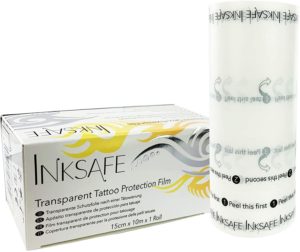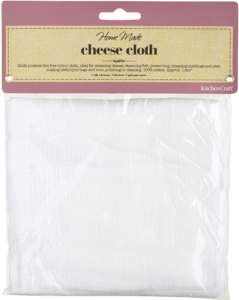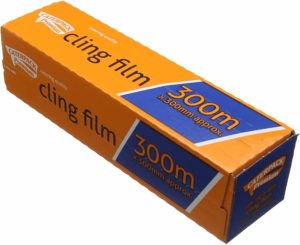Your tattooist most likely wrapped your tattoo before sending you on your merry way home. And now you’re wondering how long the sterile bandage or cling film is supposed to stay on your fresh tattoo – a couple of hours? 24 hours? 3 days? I know, it’s very confusing! Aftercare instructions are literally all over the place, and various tattooists recommend different things.
So, in this article, we’ll do our best to sort this whole thing out. You’ll learn everything about tattoo wrapping – the do’s and don’ts, and all the little details that will help you take better care of your new ink!
Page Contents
Why tattooists wrap freshly done tattoos
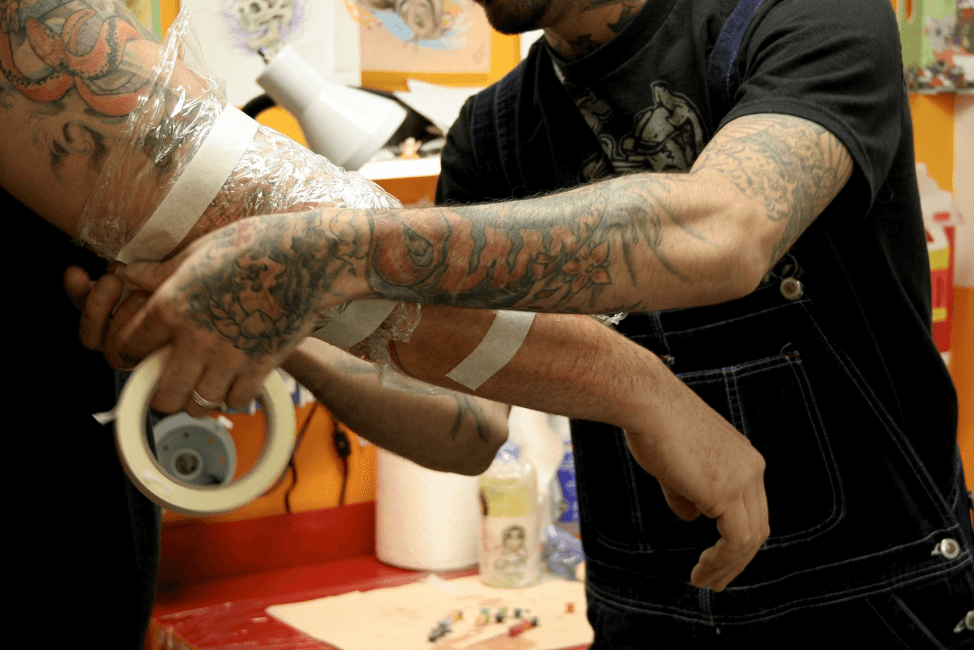
An artist wrapping his fresh handiwork (Photo by Angie Torres)
There’s a lot of reasons why professional tattooists wrap their brand-new work in sterile bandages or cling film:
Firstly, they may be required by law to do so. Obviously, rules vary by country, state, province, city. A licensed tattooist will know what his legal and moral obligations are.
Secondly, the wrap/film/bandage serves as a physical skin barrier. It protects your ultra-fresh, open wound (your tattoo IS an open wound) from dust, germs, bacteria, smoke, pet hair, and other contaminants.
Thirdly, it protects your all-too-tender skin from knocks, bumps and all sorts of physical contact in your surroundings.
How long should the initial wrap be on?
There’s a lot of conflicting information out there on the web. Some may say to leave it on for an hour or two – just enough time to get home, peel off the wrap and wash it. Other tattooists will tell you to leave it on overnight (that means sleeping with the cling film on). Then, in the morning, wash it with warm water and mild soap.
So, which is correct?
Well, it really depends on your tattooist. Since there is no standard aftercare advice, your tattooist is the authority you should listen to. Their aftercare advice is rooted in personal experience, client experience, and their colleagues’ experiences.
Now, no true professional will ever give you bad advice. This is because the tattooing industry is a relatively small one. Most artists rely on word-of-mouth advertising to get new clients. The better their tattoos look, the happier their clients are, and the more likely they’ll be to recommend their tattooist to their friends. It’s a win-win, all around.
Again, while the tattoo wrapping – and aftercare – information out there may be conflicting, your tattooist will have your best interests at heart. You are their walking portfolio, after all.
So, to answer the question, keep your tattoo wrapped in cling film for however long your tattooist tells you to.
Should you re-wrap your tattoo on your own?
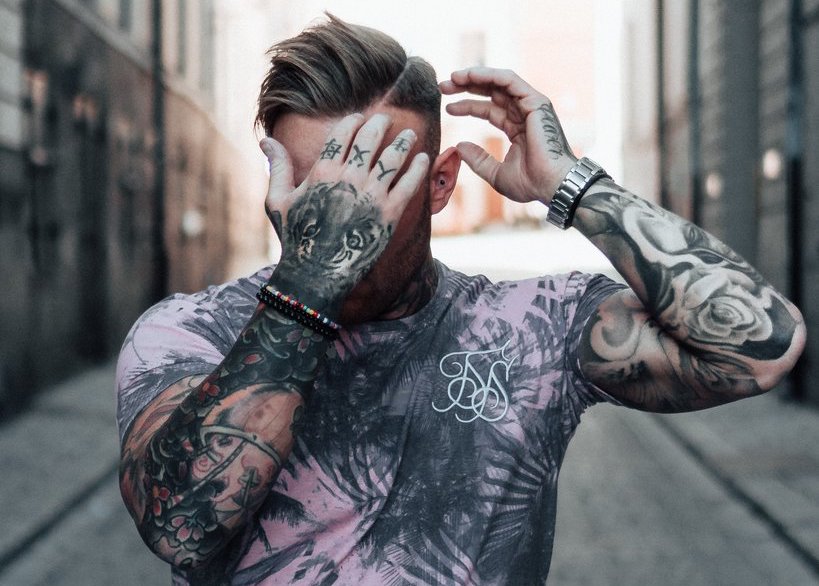
Tattooed man covering his face with his hands (Photo by Steven Erixon)
Earlier in this article, you learned why tattooists wrap their fresh work at the studio. But when you take that initial wrap off, is it safe to put another one on? Well, it really depends on a few things:
- Where do you plan on putting on the new wrap? Is it a clean environment?
- Do you have impeccable personal hygiene and sanitation?
- How experienced are you with tattoos? Is this your first, second, third, or nth time?
As you can see, hygiene and sanitation are important when it comes to re-wrapping tattoos on your own.
At the tattoo studio, it’s a different environment. First of all, it’s purposely sterile – everything is literally covered in disposable plastic wrap to protect clients and tattooist(s) alike.
Secondly, a professional will take great care to clean the tattoo before the wrap is placed; this ensures no bacteria gets trapped underneath.
Now, the question is, can you replicate the same sterile environment at home?
If yes, then feel free to go ahead and re-wrap your tattoo. Otherwise, you may be better off following other aftercare methods, such as dry healing and using healing ointment to protect the area.
What to wrap your new tattoo with
Most tattooists use protective cling film for their fresh handiwork. However, when re-wrapping, it’s best to use something that will at least let the skin breathe. Oxygen is essential to wound healing, so we recommend airing it out as often as possible. That said, these are some of the most effective products you can use to wrap your new ink with:
Breathable tattoo protection film
We recommend Inksafe’s tattoo protection film. It’s a transparent, waterproof bandage perfect for use on healing tattoos. This type of film is also known as ‘second skin tattoo bandage’ because it acts like a second layer of skin on top of your tattoo!
The product pictured above is 10 meters in length – perfect if you’ve got a relatively large, fresh tatt. It’s safe to leave this on the skin for up to 4-5 days; this is because the film allows the skin to breathe. Some users say they had no issues taking a quick shower with the film on – it stayed perfectly in place!
Cheesecloth
In addition to cheesemaking, you can use cheesecloth as a bandage for healing wounds, including tattoos. KitchenCraft’s Home Made Cheesecloth is fairly comfortable, so it’s not going to pull at your skin or any growing hairs in the area. It’s also washable and reusable, so a single cloth will prove to be a solid investment (although it already is quite cheap to begin with). The cloth will allow your skin to breathe, but at the same time, it will absorb the fluids from your healing tattoo, so it’s best to change the dressing once or twice daily.
Cling film
Use cling film (for example, Caterpack’s as pictured above) as a last resort. Usually, this type of material is made with plastic, which means it won’t allow air to get in or out of the wound. If kept on the skin for too long, it can create the perfect breeding ground for bacteria, especially if the area wasn’t thoroughly cleaned before the film was put on. If you do use cling film, make it a point to change every 3-4 hours to keep the area clean – and to let some air in from time to time.
How to re-wrap a tattoo on your own
Alright, if you’ve got a clean place to do the wrapping, then here’s what you need to do to re-wrap on your own.
- Wash your hands thoroughly first. Then avoid touching anything else that may get your hands dirty again.
- Wash the tattoo with warm water and mild, non-perfumed soap to wash all the gunk away.
- Let the area air-dry. Or, pat dry with kitchen roll or clean cloth (do not rub).
- Once the tattoo is dry and clean, apply the wrap carefully making sure it covers the entire tattoo.
- Depending on the wrap used, you may need to use an adhesive or tape to keep it steady. Add an extra inch or two for allowance, so no pressure is applied to the still-tender area. This also allows the oozing gunk to move off the tattoo.
Now, if you need help with the wrapping (say, your tattoo is at a hard-to-reach spot), make sure your friend washes their hands as well.
How long should you keep your tattoo re-wrapped?
Well, it truly depends on the kind of wrap used. If you use cling film (it doesn’t let the air in), then you’d definitely need to let it breathe often. In this case, you’d need to change the wrap every 4-6 hours or so. For other wraps like sterile bandage, gauze, cheesecloth, and breathable tattoo films, then a once-daily change may be fine.
Note, however, that for some brands of breathable tattoo protection films, manufacturers claim it’s okay to leave the film on for up to 4-5 days. So, check the label for instructions. If unsure, speak with your tattooist.
Should you wrap your tattoo for work?
This is a tricky question. It really depends on the nature of your work. If you work a white-collar job, that is, in an office environment, then wrapping your tattoo may not be necessary. However, if you work in a kitchen, garage, farm, and similar blue-collar jobs, then re-wrapping may be necessary, especially if your work environment is not suitable for a healing tattoo.
How to take off a tattoo bandage
Very, very carefully. Some tattoo wraps may be a bit difficult to remove. And if you’re not careful, the film may stick to the skin and draw some ink out. If this happens, you can try removing the film under flowing, warm water. This will hopefully make the removal a much less worrying experience. Remember, make sure your hands are clean before you attempt to remove the bandage.
When to re-wrap your tattoo?
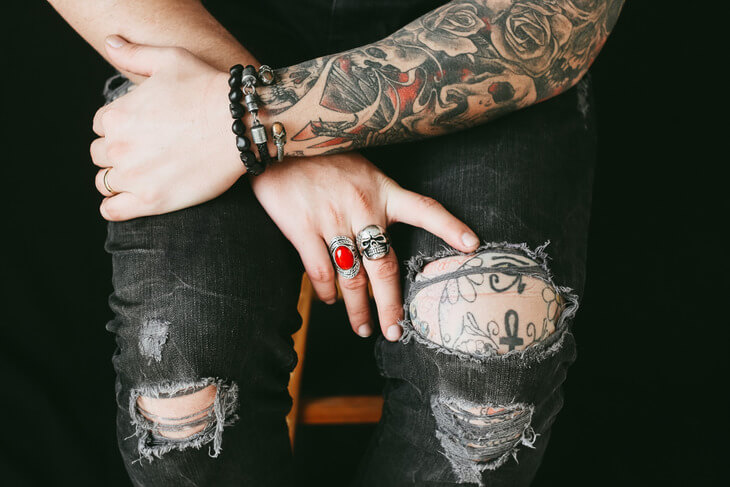
You can re-wrap if necessary (Photo by Matheus Ferrero)
Sometimes, re-wrapping becomes a necessity and not just a tattoo healing option. Here are a few scenarios where you may need to re-wrap to protect your ink:
Sleeping
Sleeping in a new tattoo can actually be done without re-wrapping it. However, you’d need to take a few precautions. This is so the area doesn’t get infected and the gunk doesn’t ooze into your clothes, bedsheets, etc. If you think this is way more trouble than it’s worth, consider re-wrapping or re-bandaging your tattoo.
Wearing clothes that will rub against the tattoo
When at home, wear loose clothing to allow your tattoo to breathe. However, if you need to go to work and your work clothes are going to rub on the area, then it’s best to cover it up for protection.
When in a dirty environment
As much as possible avoid going to filthy places. Protect your tattoo especially while the needle wounds are still open and oozing.
When anticipating contact
If you get tattooed in an area that gets lots of contact, e.g. your hands and arms, then a sterile bandage may better protect the ink and keep your tattoo away from infection. For instance, when playing sports, you may get more than just a few bumps and knocks, so tattoo protection should be taken into account.
When should you stop wrapping your tattoo?
The best time to stop wrapping your tattoo is when it finally stops weeping and/or starts scabbing. This means the needle puncture holes would have closed up and there’s less chance for bacteria to enter and infect your tattoo. However, if you still want to protect the scabs, i.e. keep them from getting ripped off prematurely, then putting a sterile dressing on top should be fine.
Conclusion
Tattoo wrapping (or re-wrapping) is best done under sterile conditions. You’re doing it to protect your new ink and, of course, speed up the healing process. Do it right, and you need not worry about getting your tattoo infected.

